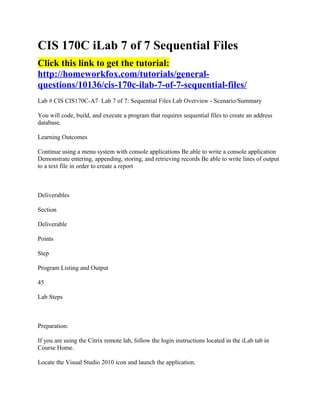
CIS170C Lab 7: Sequential Files
- 1. CIS 170C iLab 7 of 7 Sequential Files Click this link to get the tutorial: http://homeworkfox.com/tutorials/general- questions/10136/cis-170c-ilab-7-of-7-sequential-files/ Lab # CIS CIS170C-A7 Lab 7 of 7: Sequential Files Lab Overview - Scenario/Summary You will code, build, and execute a program that requires sequential files to create an address database. Learning Outcomes Continue using a menu system with console applications Be able to write a console application Demonstrate entering, appending, storing, and retrieving records Be able to write lines of output to a text file in order to create a report Deliverables Section Deliverable Points Step Program Listing and Output 45 Lab Steps Preparation: If you are using the Citrix remote lab, follow the login instructions located in the iLab tab in Course Home. Locate the Visual Studio 2010 icon and launch the application.
- 2. Lab: Step 1: Requirements: An Address Database Create a C++ console application that will store and retrieve names and addresses in a text file. The program should do the following. It should accept a series of names and addresses from the console. The user's input should be written to a text file in the CSV format described in the lecture, but do not include the field names in the first row of the file. Read the records from the text file, and display them in a user- friendly format. Provide a menu to allow the user to append records to the file, display the records, or exit the application. Build upon the code below to complete the assignment. //Specification: Append and display records in a address database #include <iostream> #include <fstream> #include <string> using namespace std; void menu(void); void writeData(void); void readData(void); string * split(string, char); const char FileName[] = "TestAddress.txt"; int main () { menu(); return 0; } //end main void menu(void) { //allow user to choose to append records, display records or exit the program }//end menu void writeData(void){ //Write the Address Info to a file }//end write data
- 3. void readData(void){ //read data from a file //use the split function to break a //deliminated line of text into fields }//end read data string * split(string theLine, char theDeliminator){ //Break theline into fields and save the fields to an array. //Each field will occupy one element in a character array. //theLine is a string with fields separated with theDeliminator character. //Assumes the last field in the string is terminated with a newline. //Useage: string *(lineBuffer, ','); //determine how many splits there will be so we can size our array int ; for(int ; i < theLine.size(); i++){ if (theLine[i] == theDeliminator) splitCount++; } splitCount++; //add one more to the count because there is not an ending comma //create an array to hold the fields string* theFieldArray; string[splitCount]; //split the string into seperate fields string ; int ; for(int ; i < theLine.size(); i++){ //read each character and look for the deliminator if (theLine[i] != theDeliminator) { theField += theLine[i]; //build the field } else { //the deliminator was hit so save to the field to the array theFieldArray[commaCount] = theField; //save the field to the array ; commaCount++; } } theFieldArray[commaCount] = theField; //the last field is not marked with a comma... return theFieldArray; } //end split Step 2: Processing Logic
- 4. Using the pseudocode below, write the code that will meet the requirements. The pseudocode for the writeData function is shown below. Start open the text file to append start do while loop Allow user to enter name store name (using getline method) Allow user to enter city store city (using getline method) . . write name, city, etc. to the file end loop close the file End The program input should appear similar to this. Append Records Name..........John Smith Street.........902 Union Ave City............Any Town State...........TX Zip Code......78552 "Enter another Record? (Y/N) " The file structure should look like this.
- 5. John Smith, 902 Union Ave, Any Town, TX, 79552 Eric Jones, 345 State Way, Fresno, CA, 93432 ... The file output should appear similar to the following. Show Records __________________________________________ Record #1 Name...........John Smith Street..........902 Union Ave City.............Any Town State...........TX Zip Code......78552 __________________________________________ Record #2 Name...........Eric Jones Street..........345 State Way City.............Fresno State...........CA Zip Code.......93432 __________________________________________ (A)ppend Records, (S)how Records, (E)xit Step 3: Create a New Project Create a new project and name it LAB7. Write your code using the processing logic in Step 2. Make sure you save your program. Step 4: Compile and Execute a) Compile your program. Eliminate all the syntax errors. b) Build your program and verify the results of the program. Make corrections to the program logic, if necessary, until the results of the program execution are what you expect. Step 5: Print Screenshots and Program Capture a screen print of your output. (Do a print screen and paste into an MS Word document.) Copy your code and paste it into the same MS Word document that contains the screen print of your output. Save the Word document as Lab07_LastName_FirstInitial.
- 6. END OF LAB